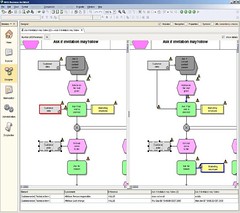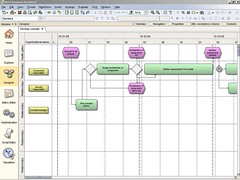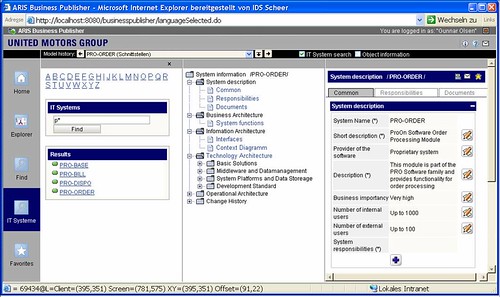The final keynote of the first day was given by Dr. Wolfram Jost, who has responsibility for the ARIS product line. I have a bit of difficulty sorting out the European titles sometimes; his title is “Executive Board Member responsible for products”, which in North America would translate to “VP of product management” or something similar.
He makes a distinction between the “business layer” and “technical layer” of BPM, where the technical layer appears to be defined as the BPMS and other systems (such as SAP) that are used to execute business processes, and the business layer (ARIS) is used to monitor and manage the performance of the processes. Interestingly, they’re putting performance management ahead of modeling in importance, even though they’re likely better known for modeling; performance management is much more closely tied to process improvement in people’s minds, even though you likely wouldn’t get to that point if you didn’t model the processes in the first place, and the models provide a framework on which to hang the measurement data.
Jost sees a convergence of major improvement initiatives within organizations: BPA/BPM, SOA, EA, BI and GRC (governance, risk and compliance). To address this, ARIS is bundled as solutions to approach these initiatives on top of the base ARIS platform.
He covered some of the new functionality in the upcoming product release with respect to modeling:
- Versioning of models
- WYSIWYG report designer
- Timeline display of models
He also reinforced how they provide a standard modeling and performance management platform for a number of different implementation platforms, from ERP platforms such as SAP to BPMS such as TIBCO or Fujitsu.
There’s some completely new functionality in this product release as well, such as the IT Inventory capability.
He went on to discuss how by the end of 2008, they will release a process execution environment “for governance processes”, the subtlety of which escapes me somewhat — does that mean that they are about to become a full-up BPMS, or only for specific types of processes? If they do release an execution environment that operates directly from the models in their repository, they’ll definitely annoy some of their BPMS business partners, but more importantly, they have the potential to become one of the most powerful BPM suites around because of the top-notch modeling and performance management. I have an interview tomorrow morning with someone in product development that should help to clear up my fuzziness on this — tune in then for more.




My sense is Dr. Jost describes the ‘narrow’ view of enterprise performance management as being process improvement and dashboard measures. It so so much broader including strategy execution, customer economic value targeting, rolling financial forecasts, and predictive analytics to name a few. Including governance and compliance is something diffeent and, in my opinion, are outside the scope of performance management. — Gary Cokins
Gary, I expect that you are correct in your assessment of what they do in terms of performance management. However, there are many vendors using equally narrow definitions of performance management that I didn’t take note of it.
My big complaint is that they refer to what they do as “business process management” when the analysts’ definitions of BPM really define a core part of BPM as having an execution environment. Of course, judging by the interview that I had with their product head, some of that will be coming later this year.